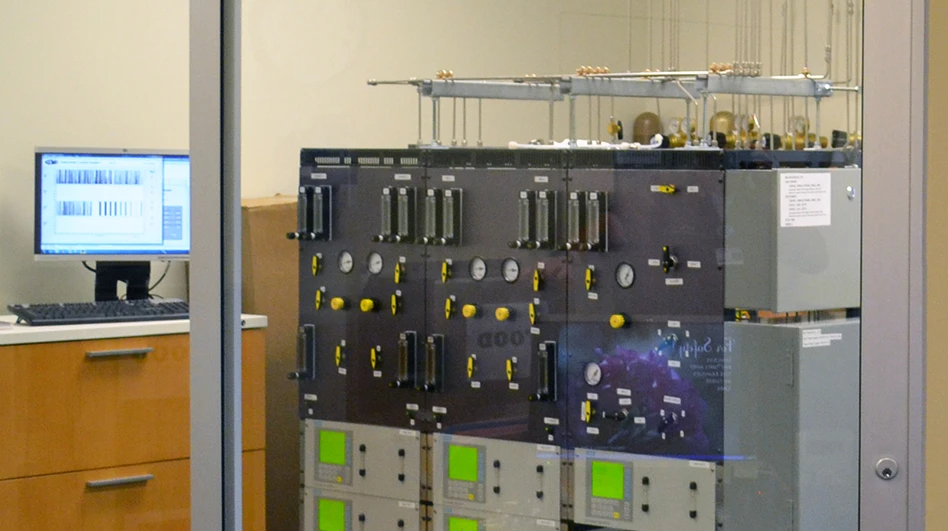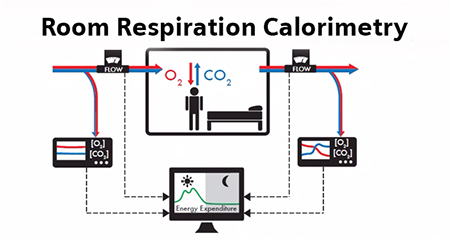
SIEMENS/MEI RESEARCH
Around the globe, incidences of metabolic diseases are rising. Obesity can lead to severe health complications, shortened life expectancy, and exposure to stigma and discrimination. It is a significant risk factor for Type 2 diabetes, fatty liver disease, and other conditions.
In fact, over 40% of U.S. adults are living with obesity today, compared to just 12% in 1990. And nearly 20% of today’s U.S. children and teenagers are also living with obesity. The worldwide prevalence of obesity is increasing, too.
Academic and government researchers use room respiration calorimeters to explore the dietary factors affecting human metabolism. Respiration calorimeters measure a person’s energy expended through the oxygen they use (VO2) and carbon dioxide they produce (VCO2).
Room calorimeters are typically the size of a bedroom and offer a comfortable environment for subjects (especially for children), with a bed, desk, computer, flat panel TV, and bathroom. Such amenities allow researchers to conduct studies up to two to three days.
MEI Research is based in a Minneapolis suburb and is a leading provider of room respiration calorimeters. The company designs, builds, and renovates whole-body respiration calorimeters to measure minute-by-minute energy expended and substrate utilization. MEI supports entire research projects with study automation, data management and technical support services, especially in the areas of nutrition and weight management.
Challenge: Provide client researchers with room calorimeters featuring the most precise and reliable VO2 and VCO2 analytics available
Room calorimeters operate via a simple concept. The calorimeter is a sealed room with only one gas inlet and one gas outlet. Air is then metered into the room through the inlet port with its flow rate, O2 concentration, and CO2 concentration measured. As the individual breathes the room air, consuming O2 and producing CO2 through known metabolic processes, the air is then drawn from the room through the outlet where O2 concentration and CO2 concentration are again measured.
For a period specified by a research study’s goals with meals and activities carefully prescribed. VO2 and VCO2 are calculated from the difference in the inlet gas concentration from the gas concentration in the room, thereby providing researchers data to infer the subject’s metabolic responses to specific foods they’ve eaten according to the diet being studied.
According to Erica Wohlers, a senior biomedical engineer and project manager at MEI, one of the biggest challenges its research clients face is accurately measuring respiration from their research subjects. “They’re looking at the rate of change in a person’s VO2 and VCO2 to measure their metabolism and determine how many calories they’re burning and substrate utilization such as dietary fats, carbs, or proteins that are fueling their metabolism.”

| http://www.meinergy.com
calorimetry works.
“A bedroom-sized chamber can hold 30,000 liters of air, so our gas analyzers need to be exceptionally sensitive and precise to detect changes in VO2 and VCO2 levels,” Wohlers adds. “And they have to be reliable, too. Otherwise, the data of entire research project can be undetermined and the costs in money, time, and effort wasted.”
As an example of one representative study, Wohlers cites recent research done in conjunction with the U.S. National Institutes of Health (NIH) by a major research center that focuses on metabolism and diabetes issues.
“Our customer has four whole-room indirect calorimeters we built that provide continuous energy expenditure measurements for up to 24 hours,” Wohlers explains.
In this study, scientists studied the metabolic effects impacts of a ketogenic diet versus a standard American diet. They analyzed multiple data sets to assess the body’s biochemical, cellular, metabolic, and immune responses, as well as changes to the microbiome. The precision of their measurements, especially related to VO2 and VCO2 levels, was critical to their investigation.

| http://www.meinergy.com
Solution: Deploy Siemens ULTRAMAT/OXYMAT 6 gas analyzers in each room calorimeter’s sensing fabric
Even before MEI Research began designing calorimeters commercially in 2008, they visited factories in several countries to select process analyzers for the human respiration calorimeter facility for the Children’s Nutrition Research Center at Baylor College of Medicine. The Siemens gas analyzers provided the best value in terms of precision, reliability, installation, and maintenance. Since then, MEI has continued using Siemens gas analyzers, namely ULTRAMAT/OXYMAT 6 models.
Today, the company deploys those gas analyzers in its turnkey whole-body, room respiration calorimeters – both new-builds and renovations – which are a flagship offering in its portfolio. That’s in addition to its PiLR Health monitoring platform and custom development services.
“For the gas analyzers in our room respiration calorimeters, we continue to use the ULTRAMAT/OXYMAT 6 models primarily because they deliver consistently precise and repeatable results,” Wohlers says. “At the same time, they’re reliable as well as easy to install and maintain."

| http://www.meinergy.com
room outside the room calorimeter.
Each Siemens ULTRAMAT/OXYMAT 6 gas analyzer combines in a single, 19" (48.3cm) enclosure these two analyzers:
ULTRAMAT 6: This device uses the non-dispersive infrared (NDIR) dual-beam differential mode process for measurements. It can selectively measure gases whose absorption bands are in the infrared wavelength range between 2µm and 9µm. It can be configured to sample CO, CO2, NO, SO2, NH3, H2O as well as CH4 and other hydrocarbons.
OXYMAT 6: Its measurement channel is based on the paramagnetic alternating pressure measurement methodology used to measure oxygen in gases. MEI is able to use this technology to achieve accuracies of ±50ppm and even more with assistance from Siemens process instrumentation engineering teams. Researchers also have the flexibility to suppress its measurement range as appropriate for various studies, including normo-baric hypoxia.

| http://www.meinergy.com
“For example, we suppress the range to 20% to 21% during normal calorimeter operation to optimize resolution,” Wohlers says. “And for hypoxia studies, we increase the range to 15% to 21% O2.”
To achieve that greater resolution, MEI’s local Siemens value-added distributor Jasper Engineering connected MEI with Siemens and facilitated an engineering effort to extend the VO2 and VCO2 measurement resolution of the ULTRAMAT/OXYMAT 6 gas analyzer from four-nines to six-nines or 99.9999%. “Jasper Engineering has always been a strategic partner to MEI and available whenever we need them,” Wohlers says. “They’ve really taken the time to understand our business and advise us.”
She adds: “The readiness and responsiveness of Siemens engineers to help us do that was another big point in favor of using their gas analyzers. They’ve enabled us to provide our client customers with even more measurement precision for their calorimetric research. And it further establishes MEI as the leader in providing the very best room calorimeters available.”
Results: Reliable room calorimeters, capable of high precision, research flexibility, and easy operation
Whether MEI is providing its many metabolic research clients with a newly built room calorimeter or renovating their existing ones, Wohlers is sure Siemens ULTRAMAT/OXYMAT 6 gas analyzers will provide the needed data precision and accuracy to draw insights to address related diseases and conditions around the world.
In addition, Wohlers points out that the Siemens ULTRAMAT/OXYMAT 6 gas analyzer is easy to install and maintain. “When we’re adding a unit to our rack, it’s simply a matter of sliding the all-in-one enclosure into the rack with a few screws to hold it in place, then just connect our plumbing to its outlets,” she says. “As for maintenance, we have to change the inline particulate filters periodically and also change the reference tank of compressed air as needed, which takes just a day, including calibration.”
But Wohlers and MEI don’t just design, engineer, and build room calorimeters for today; they’re looking far out into the future. “For our research clients’ sake as well as our own, we have to keep looking out 20 to 30 years, which is the operating lifecycles of our room calorimeters and make informed projections of where metabolic research may be going,” she says. “Of course, while the future will always unpredictable, we know we can count on Jasper Engineering and Siemens to be there for us.”
Latest from Today's Medical Developments
- ZOLLER events will showcase the company’s cutting-edge innovations
- THINBIT’s MINI GROOVE ‘N TURN Acme threading inserts
- CMMC Roll Out: When Do I Need to Comply? webinar
- Mazak’s SYNCREX 38/9 Swiss-type production turning machine
- Current economic and geopolitical realities demand decisive action
- Collaboration to advance pediatric medical technologies
- Guyson's TR-1000 Custom Vertical Blast System
- Intelligent data for the digital factory





